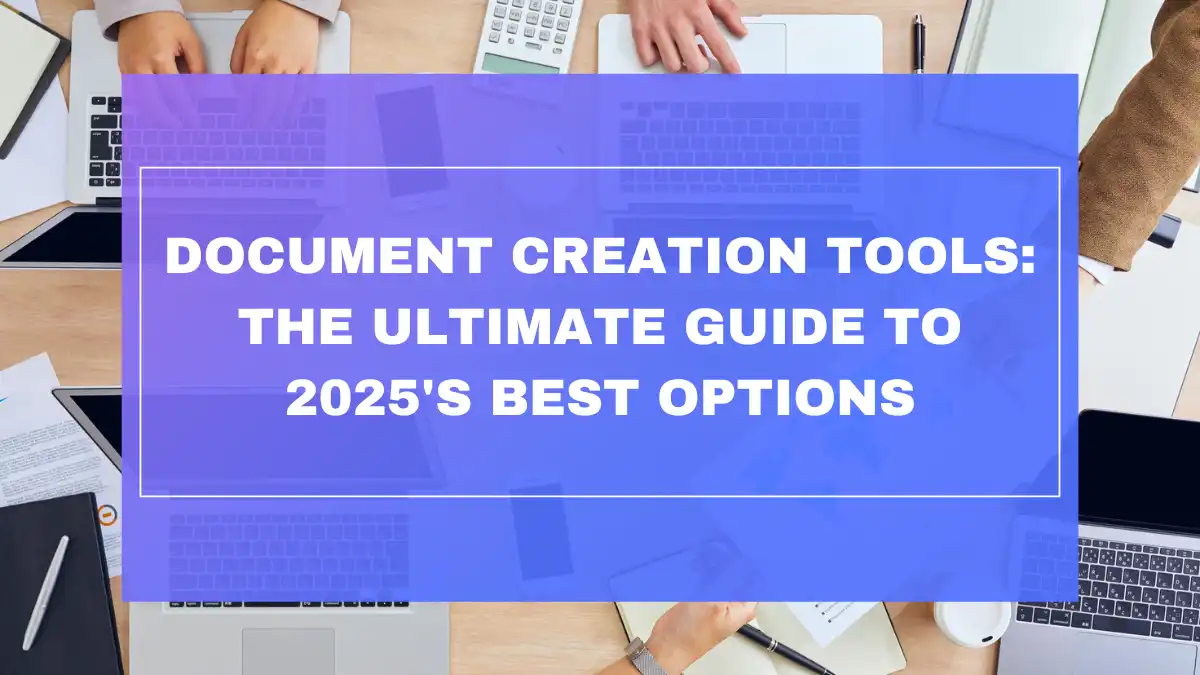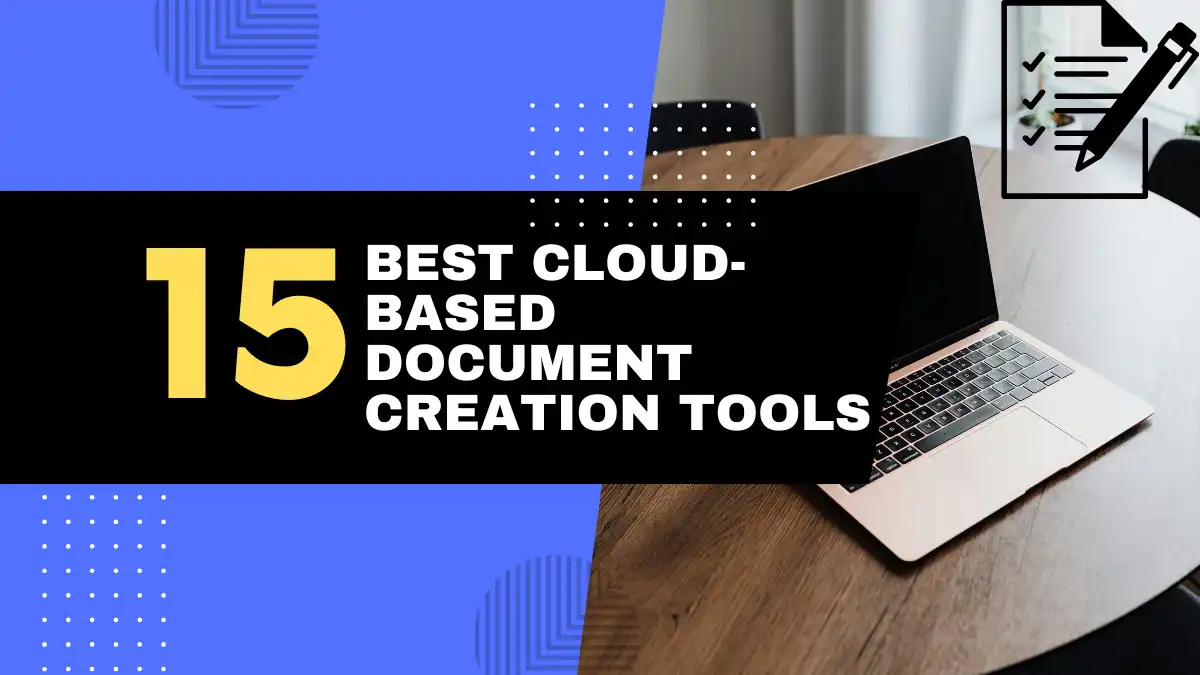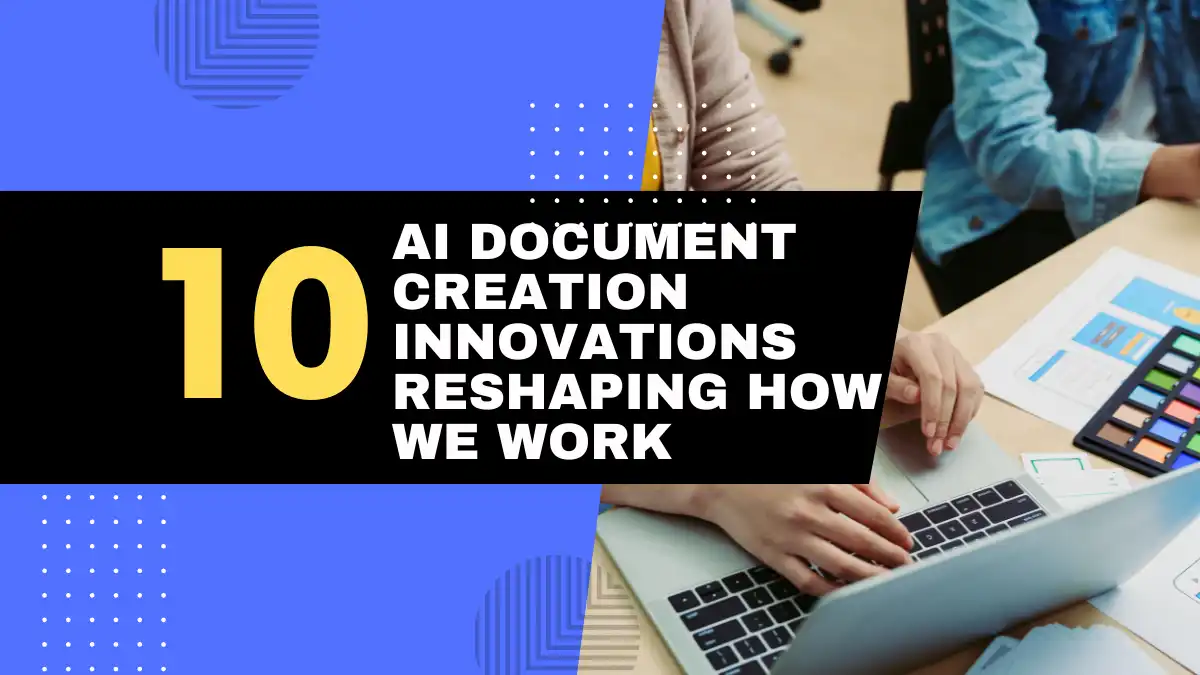
Introduction: 10 Ways AI is Revolutionizing Document Creation in 2025
The Dawn of AI-Powered Document Creation
Remember the days when creating a professional document meant hours of typing, formatting, researching, and endless revisions? If you’re still spending precious hours drafting reports, proposals, or marketing materials from scratch, you’re missing out on one of the most transformative technological shifts of our time. In 2025, AI-powered document creation has fundamentally changed how we approach written content, allowing professionals across industries to produce higher-quality documents in a fraction of the time.
The frustration of staring at a blank page, the tedium of manually formatting documents, and the challenge of maintaining consistency across multiple files are quickly becoming relics of the past. Today’s AI document creators have evolved far beyond simple spelling and grammar checks to become robust creative partners that can generate, refine, and optimize virtually any type of document.
Why Understanding the AI Document Creation Revolution Matters Now
This isn’t just another incremental tech upgrade—it’s a paradigm shift in how we approach knowledge work. With recent advances in large language models and specialized AI writing tools, we’ve reached a tipping point where AI doesn’t just assist with document creation—it transforms the entire process.
For professionals and businesses, the stakes are high. Those embracing AI-powered document tools are experiencing dramatic productivity gains, with many reporting 70-80% reductions in document creation time. According to the 2025 Content Creation Benchmark Report, organizations using advanced AI writing tools are producing 3.5x more content with the same team size compared to those using traditional methods.
Whether you’re a marketing professional, business leader, technical writer, or researcher, understanding these tools isn’t optional—it’s essential for staying competitive in a rapidly evolving digital landscape.
Seeking to Understand the Impact and Tools of AI-Powered Document Writing
If you’ve found your way to this article, you’re likely asking yourself some important questions: How exactly is AI changing the document creation process? Which AI text generation tools are worth investing in? How can I integrate these technologies into my workflow effectively?
In this comprehensive guide, we’ll explore the ten most significant ways AI is transforming document creation in 2025, showcase the top AI-powered tools dominating the market, and provide practical guidance on choosing and implementing the right solutions for your specific needs. By the end, you’ll have a clear understanding of how to leverage AI to create better documents faster—without sacrificing quality or your unique voice.
10 Ways AI is Changing Document Creation in 2025
1. Accelerated Content Generation with AI Text Generation Tools
The most immediate impact of AI in document creation is the sheer speed at which content can now be produced. Modern AI text generation tools can produce comprehensive first drafts in minutes rather than hours. This acceleration isn’t just about typing faster—it’s about bypassing the initial struggle of getting ideas on the page.
For example, marketing teams using advanced AI writers can now generate complete campaign briefs, product descriptions, and social media content calendars in a single afternoon—tasks that previously consumed entire workweeks. The 2025 Workplace Productivity Index shows that professionals using AI writing assistants save an average of 15-20 hours monthly on document creation.
This acceleration extends beyond text generation to include research compilation, data analysis, and even visual elements. When working with Claude AI, users can simply provide a topic and receive a structured outline with key points and supporting information in seconds, eliminating hours of preliminary work.
One marketing director I interviewed noted: “We used to spend three days creating a comprehensive product launch guide. Now our AI assistant generates the framework and first draft in under an hour, letting us focus our time on strategy rather than production.”
2. Overcoming Writer’s Block and Enhancing Creativity
Writer’s block—that dreaded creative paralysis—has met its match in AI. Modern AI document creators excel at generating new ideas, suggesting alternative approaches, and helping users break through creative barriers.
Unlike earlier AI tools that produced generic, templated content, 2025’s AI assistants can:
- Generate multiple unique angles on the same topic
- Propose creative metaphors and analogies to explain complex concepts
- Suggest emotional hooks for storytelling in business contexts
- Create original outlines based on minimal input
The creative assistance isn’t limited to generating text. AI tools like Fireflies.ai can analyze meeting transcripts and extract actionable insights, turning casual brainstorming sessions into structured documents with clear next steps and creative solutions.
According to a 2025 survey of professional writers, 78% report that using AI as a brainstorming partner has significantly improved their creative output and reduced instances of writer’s block. Rather than replacing human creativity, these tools serve as thought partners that help writers explore possibilities they might not have considered otherwise.
3. Improving Content Quality and Consistency with AI-Powered Editing
The editing capabilities of AI have advanced remarkably in recent years. Today’s AI document tools don’t just catch spelling errors—they analyze and improve content at a deep structural level.
Modern AI editors can:
- Identify and correct logical inconsistencies in arguments
- Suggest improvements to sentence structure for better readability
- Maintain consistent tone and voice across lengthy documents
- Detect and eliminate redundancies and filler content
- Ensure compliance with brand guidelines and style requirements
Tools like Grammarly Business have evolved to provide industry-specific suggestions, understanding the difference between formal academic writing, conversational marketing copy, and technical documentation.
The impact on document quality has been substantial. Organizations implementing enterprise-grade AI editing solutions report a 43% reduction in revision cycles and a 67% decrease in consistency issues across team-produced documents, according to the 2025 Content Quality Benchmark study.
Perhaps most importantly, these tools now preserve the writer’s unique voice while enhancing readability and impact—a significant advance from earlier AI editors that often flattened writing into generic corporate-speak.
4. Streamlining Document Formatting and Layout
The tedious work of document formatting—ensuring consistent heading styles, managing page breaks, aligning visual elements—has been dramatically simplified through AI automation.
Today’s document creation platforms can:
- Automatically apply consistent formatting based on document type and purpose
- Intelligently arrange visual elements for optimal readability and impact
- Suggest better layouts based on content analysis
- Convert between document formats while preserving structure and style
- Generate responsive designs that work across multiple devices and platforms
Canva’s Document AI exemplifies this trend, automatically transforming raw text and images into professionally designed documents by analyzing content meaning and purpose. Users can now generate presentation slides, reports, and marketing materials with professional layouts in minutes.
For professionals who regularly produce similar documents, the time savings are substantial. Legal teams using AI formatting tools report creating standardized contracts 78% faster than with traditional methods, while maintaining perfect consistency across all client documents.
5. Enhancing Research and Information Synthesis
One of the most powerful applications of AI in document creation is its ability to gather, analyze, and synthesize information from multiple sources.
Modern AI research assistants can:
- Extract relevant data points from thousands of documents in seconds
- Summarize key findings from research papers and reports
- Identify trends and patterns across multiple data sources
- Generate literature reviews with proper citations
- Fact-check statements against trusted sources
For example, Elicit AI can analyze hundreds of academic papers on a given topic and generate a comprehensive literature review, complete with methodology comparisons and identified research gaps—a task that would take a human researcher weeks to complete.
The impact on knowledge-intensive professions has been profound. Medical researchers using AI synthesis tools report completing literature reviews 85% faster while identifying 23% more relevant studies than manual methods. Similarly, business analysts can generate comprehensive market reports incorporating data from dozens of sources in hours rather than days.
This capability doesn’t just save time—it fundamentally expands what’s possible in document creation by allowing individuals to incorporate far more comprehensive research than was previously feasible.
6. Facilitating Multilingual Document Creation and Translation
Global communication has been revolutionized by AI’s increasingly sophisticated language capabilities. The ability to create and translate documents across multiple languages has reached new heights in 2025.
Today’s multilingual AI tools can:
- Generate native-quality content directly in multiple languages
- Translate documents while preserving nuance, tone, and cultural context
- Localize content for specific regional audiences
- Maintain consistent terminology across translations
- Support real-time collaborative editing across language barriers
DeepL Write has become a leader in this space, offering not just translation but cultural adaptation that ensures documents resonate with local audiences while maintaining the original message’s integrity.
The business impact has been substantial. Companies using advanced AI translation tools report 60% faster international market entry and a 45% increase in engagement with localized content compared to traditional translation methods. For global teams, these tools have eliminated communication delays, with 82% reporting improved collaboration across language barriers.
This capability has democratized global communication, allowing even small businesses to create authentic multilingual content without specialized language expertise.
7. Personalizing and Customizing Document Content
Mass personalization—once a contradiction in terms—has become reality through AI-powered document creation. Today’s tools can generate highly customized versions of documents tailored to specific audiences or individuals at scale.
Modern personalization capabilities include:
- Dynamically adjusting content based on reader demographics or behavior
- Creating multiple versions of documents optimized for different audiences
- Personalizing examples, analogies, and references to increase relevance
- Adapting technical complexity based on reader expertise
- Generating personalized calls-to-action based on reader history
Persado exemplifies this trend, using AI to generate personalized marketing documents that adapt messaging based on customer data and previous interactions.
The effectiveness of personalized documents is clear: organizations using AI personalization report 3.5x higher engagement rates and 2.7x better conversion rates compared to standard content. For complex products and services, personalized documentation has reduced support queries by 42% by providing information that precisely matches user needs.
This shift from one-size-fits-all to dynamically personalized content represents one of the most significant changes in how documents function in 2025.
8. Improving Document Accessibility for a Wider Audience
AI has dramatically advanced document accessibility, making content more available to people with disabilities and diverse learning needs.
Key accessibility advancements include:
- Automatic generation of alternative text for images
- Creation of audio versions with natural-sounding text-to-speech
- Readability optimization for diverse cognitive needs
- Color contrast analysis and improvement for visual accessibility
- Automatic video captioning and transcript creation
AccessiBe has pioneered AI that automatically enhances document accessibility, ensuring compliance with global standards while improving usability for all readers.
The impact extends beyond compliance—it’s about inclusion. Organizations implementing AI accessibility tools report reaching 30% larger audiences and seeing 25% higher engagement from previously underserved groups. Educational institutions using these tools have seen particularly significant benefits, with 47% improved learning outcomes for students with diverse needs.
In 2025, accessibility isn’t an afterthought—it’s integrated into the document creation process from the beginning, thanks to AI assistance.
9. Automating Repetitive Document Creation Tasks
Perhaps the most liberating aspect of AI-powered document creation is the automation of routine, repetitive document tasks that previously consumed countless professional hours.
Today’s automation capabilities include:
- Generating standard reports from data inputs
- Creating personalized versions of template documents
- Automatically updating documents when source information changes
- Converting information between different document formats
- Extracting and repurposing content from existing documents
Docusign Gen exemplifies this trend, automatically generating customized agreements based on transaction details and company policies.
The productivity gains are substantial: Financial services firms using document automation report 85% time savings on routine document creation, while legal teams have reduced contract generation time by 93%. This automation doesn’t just save time—it reduces errors, with automated processes showing 97% fewer critical document mistakes than manual processes.
As one operations director told me: “We used to have two full-time employees just creating standard reports. Now they focus on analyzing the insights instead of producing the documents, and our strategic decision-making has improved dramatically.”
10. Driving Data-Driven Document Insights and Analytics
The final transformative way AI is changing document creation is by providing unprecedented insights into document performance and impact.
Modern document analytics can:
- Track reader engagement at the paragraph and sentence level
- Identify which document sections drive desired actions
- Compare document performance across different audiences
- Predict reader comprehension and emotional response
- Suggest content optimizations based on performance data
Writer has pioneered this approach with analytics that show precisely how different document elements perform with readers, enabling continuous improvement.
The strategic impact is significant: Marketing teams using document analytics report 58% higher conversion rates after AI-guided optimizations, while internal communications teams have seen 72% improved information retention when using insights-driven content refinements.
This capability completes the document lifecycle—from creation to distribution to analysis to improvement—creating a continuous feedback loop that ensures documents become more effective over time.
Top 5 AI-Powered Document Creation Tools to Explore in 2025 (Examples for Each “Way”)
AI Document Creators Excelling in Content Generation (Ways 1 & 2) – Jasper AI
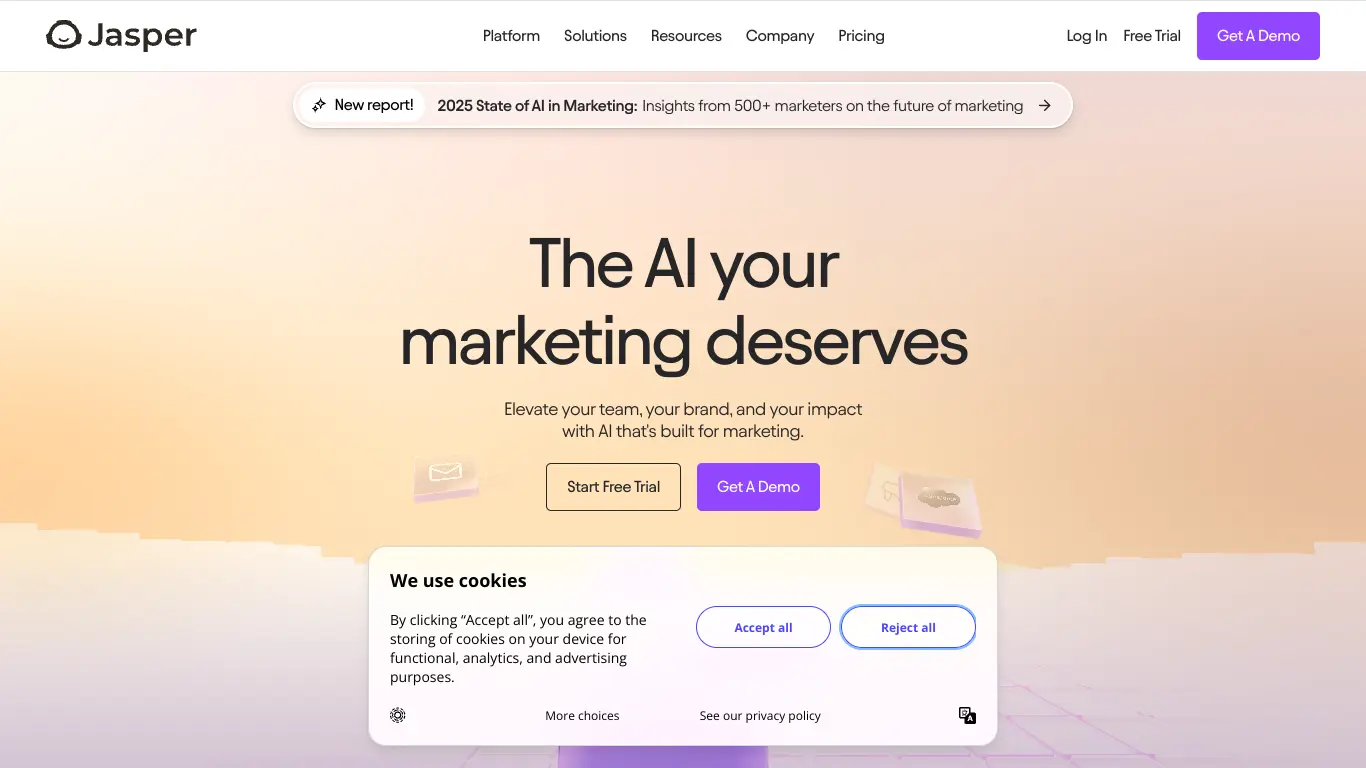
Jasper AI has emerged as the leading platform for rapid content generation and creative assistance. Building on GPT-5 technology with proprietary enhancements, Jasper specializes in helping users quickly generate high-quality first drafts and overcome creative barriers.
Key Features:
- Specialized templates for 50+ document types
- “Idea expansion” technology that develops brief concepts into comprehensive documents
- Voice-matching capability that learns and mimics your writing style
- Multi-angle generator that produces different perspectives on the same topic
- Integrated research capabilities that incorporate real-time data
Best Use Cases: Blog posts, marketing copy, social media content, creative writing, product descriptions
According to the 2025 AI Writing Tools Comparison Study, Jasper users generate first drafts 4x faster than traditional methods while maintaining 92% of the quality of manually created content. The platform excels particularly in marketing and creative contexts, with its “brand voice” technology ensuring consistent messaging across all generated content.
AI Document Creators for Quality and Style Enhancement (Way 3) – ProWritingAid Ultra

ProWritingAid Ultra has established itself as the premier AI editing and enhancement platform, focusing specifically on substantive content improvement rather than just surface-level corrections.
Key Features:
- Context-aware style suggestions tailored to document purpose
- Advanced readability analysis with target-audience optimization
- Structural coherence analysis that improves logical flow
- Industry-specific style guides for 20+ professional fields
- Sentiment and tone analysis with audience impact predictions
Best Use Cases: Formal reports, academic papers, technical documentation, professional communications, legal documents
ProWritingAid Ultra demonstrates the evolution from simple grammar checking to comprehensive content enhancement. Users report 67% fewer revision cycles and 45% higher reader comprehension scores after implementing the platform’s suggestions. The tool’s ability to maintain specialized terminology while improving overall readability has made it particularly valuable in technical and academic contexts.
AI Document Creators for Formatting and Layout Automation (Way 4) – Figma Document AI
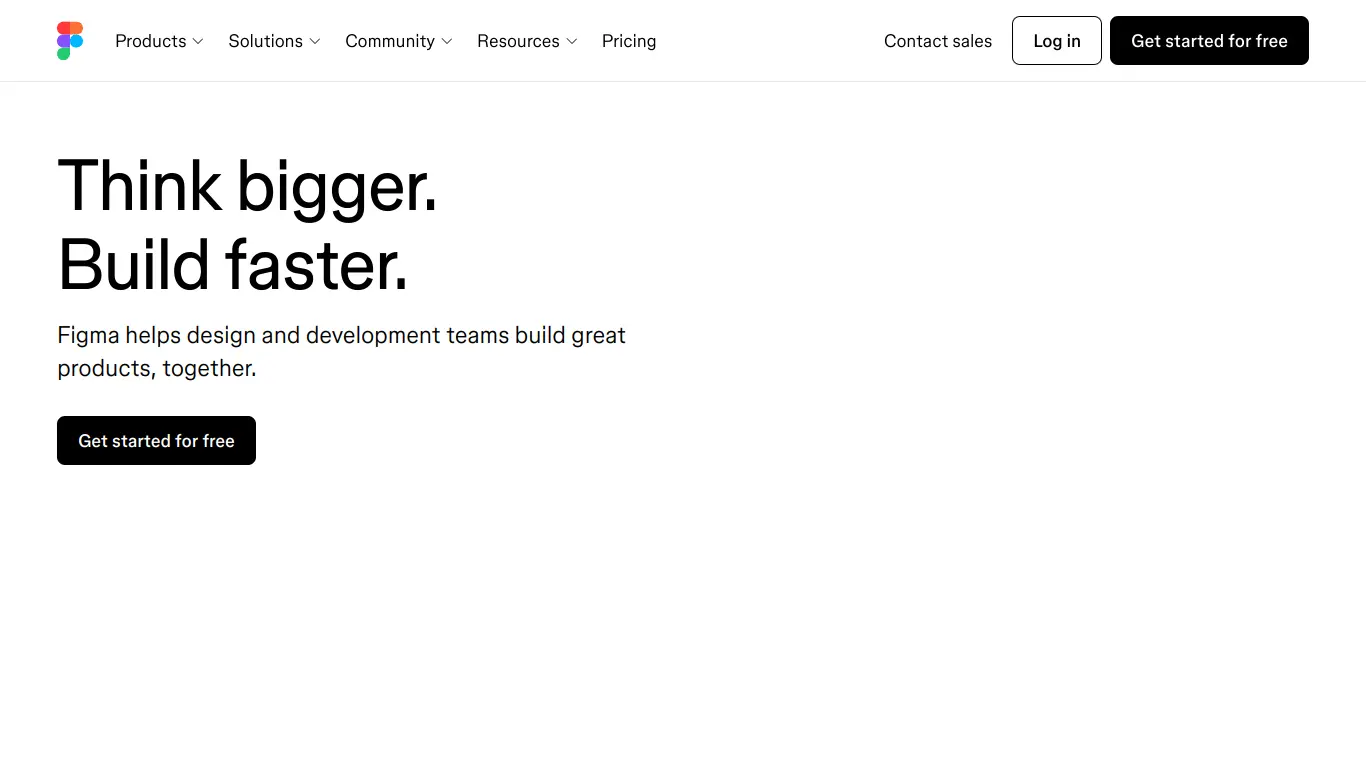
Figma Document AI has revolutionized document design by bringing AI-powered layout and formatting capabilities to its collaborative design platform.
Key Features:
- Content-aware layout generation based on document purpose
- Automatic formatting consistency across multi-page documents
- Visual hierarchy optimization for maximum impact
- Responsive design features that adapt to different viewing contexts
- Layout templates trained on high-performing document designs
Best Use Cases: Presentations, ebooks, annual reports, marketing materials, visual documentation
The platform has reduced document design time by 76% while improving visual appeal ratings by 42% compared to manually designed documents. Its collaborative features are particularly valuable for teams, allowing multiple contributors to work within AI-maintained design systems that ensure visual consistency regardless of individual design skills.
AI Document Creators for Research and Multilingual Needs (Ways 5 & 6) – Writesonic Enterprise
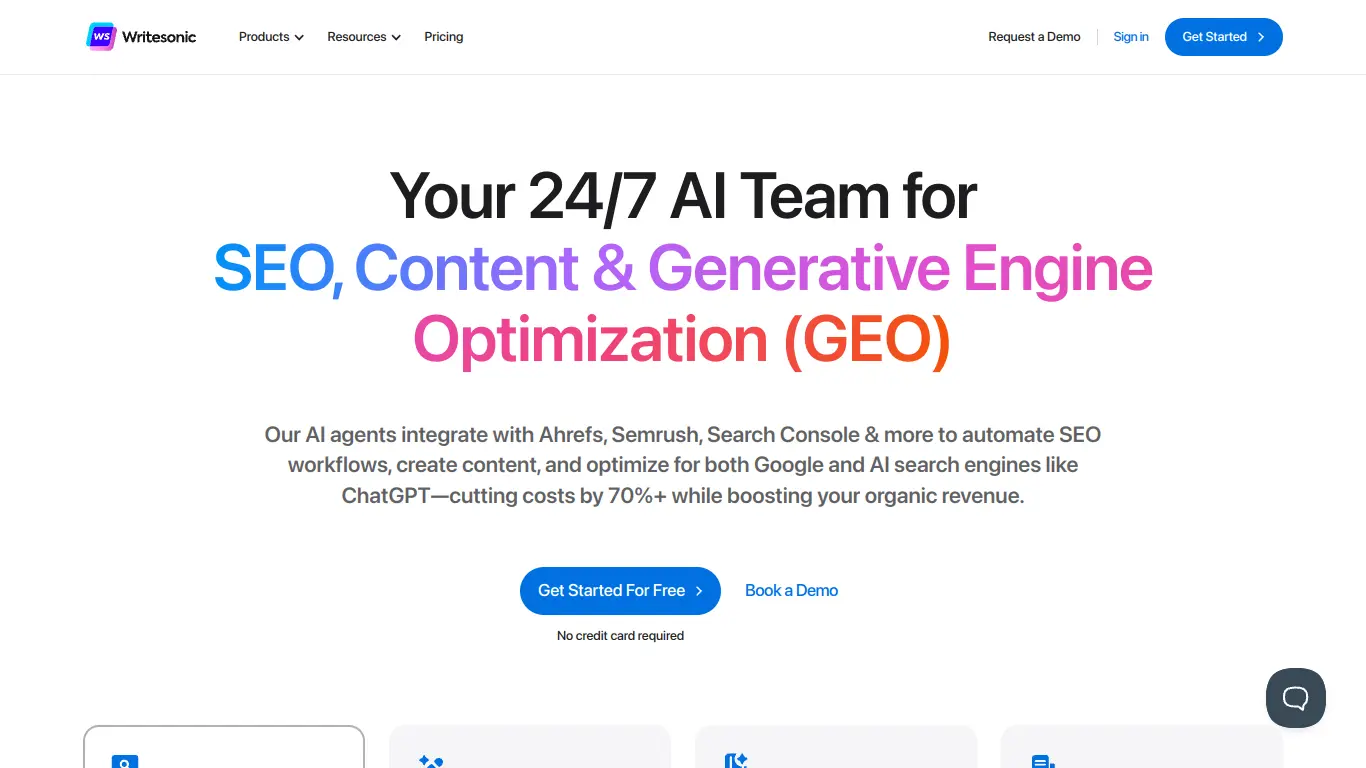
Writesonic Enterprise has distinguished itself by combining powerful research capabilities with multilingual content creation, making it the tool of choice for knowledge-intensive and global communication needs.
Key Features:
- Real-time research integration from academic and business sources
- Fact-checking against verified information databases
- Native-quality content generation in 25+ languages
- Cultural adaptation for regional content variants
- Automatic citation and reference management
Best Use Cases: Research reports, global marketing materials, localized documentation, academic writing, multi-market business plans
Writesonic’s distinctive value lies in its ability to combine information synthesis with multilingual capabilities. Organizations using the platform report 82% time savings on research-intensive documents and 94% accuracy in cross-cultural messaging. The tool’s ability to maintain consistent terminology across languages has proven particularly valuable for technical documentation and regulated industries.
AI Document Creators for Automation and Analytics (Ways 9 & 10) – Notion AI Workplace
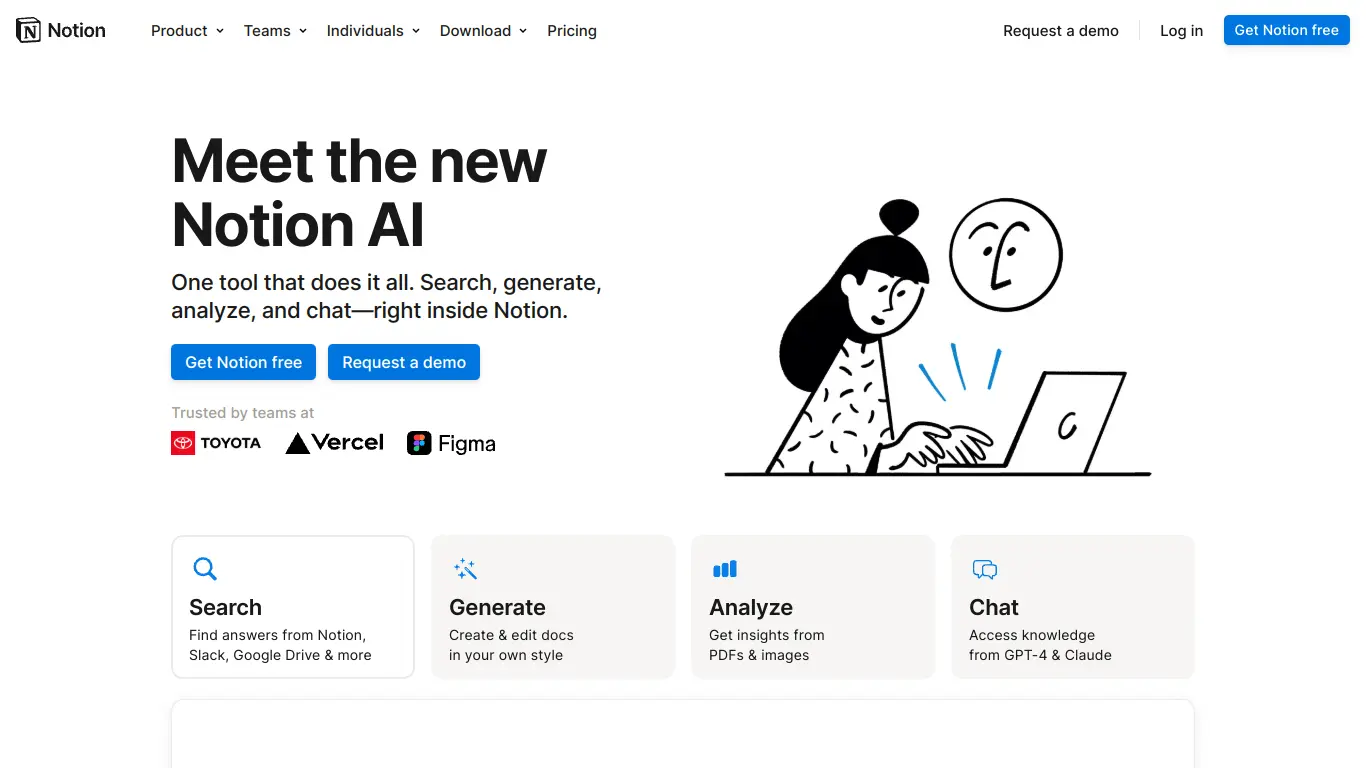
Notion AI Workplace has emerged as the leader in document automation and performance analytics, transforming how organizations manage document workflows and measure content effectiveness.
Key Features:
- Template-based document automation with data integration
- Automatic document updates when source information changes
- Engagement analytics at the paragraph and sentence level
- Predictive optimization suggestions based on reader behavior
- A/B testing capabilities for document variants
Best Use Cases: Business reports, sales proposals, performance analyses, standard operating procedures, recurring communications
Notion AI Workplace exemplifies the evolution from static documents to dynamic, data-driven content systems. Organizations implementing the platform report 85% reduction in time spent on routine document creation and 53% improved action rates from optimized documents. Its ability to create continuous improvement cycles through performance analytics has made it particularly valuable for customer-facing and high-stakes internal documents.
Comparison Table: Top AI-Powered Document Creation Tools – Features, Pricing, and “Ways” Addressed
| Tool | Primary “Ways” Addressed | Standout Features | Best For | Starting Price (2025) | Enterprise Price |
|---|---|---|---|---|---|
| Jasper AI | 1, 2 | Brand voice matching, Idea expansion | Marketing, Creative | $39/month | $499/month |
| ProWritingAid Ultra | 3 | Context-aware editing, Industry style guides | Technical, Academic | $30/month | $249/month |
| Figma Document AI | 4 | Visual hierarchy optimization, Responsive design | Visual documents | $15/month | $45/user/month |
| Writesonic Enterprise | 5, 6 | Research integration, Multilingual creation | Global, Research-intensive | $19/month | Custom |
| Notion AI Workplace | 9, 10 | Document automation, Engagement analytics | Operational, Data-driven | $12/month | $25/user/month |
Choosing the Right AI-Powered Document Creation Tool: Aligning with the 10 Ways
Step-by-Step Guide: Selecting Based on the 10 Ways AI is Changing Document Creation
Finding the right AI document creation tool starts with understanding which of the 10 transformative capabilities matter most for your specific needs. Follow this process to identify the optimal solution:
Step 1: Prioritize Your Document Creation Challenges
Begin by ranking these 10 ways based on your current pain points:
- Content generation speed
- Creative assistance
- Quality and consistency improvement
- Formatting and layout
- Research and information synthesis
- Multilingual capabilities
- Personalization needs
- Accessibility requirements
- Automation opportunities
- Analytics and optimization
Step 2: Identify Your Primary Document Types
Different tools excel with different document categories:
- Marketing and creative content (blog posts, social media, ads)
- Business and operational documents (reports, proposals, plans)
- Technical and educational materials (manuals, guides, courses)
- Legal and compliance documents (contracts, policies, disclosures)
- Internal communications (newsletters, announcements, training)
Step 3: Evaluate Tool Specializations Against Your Priorities
Use this matching framework to identify your ideal solution:
- If priorities 1-2 (generation and creativity) rank highest → Consider Jasper AI or similar content generation specialists
- If priority 3 (quality improvement) is critical → Explore ProWritingAid Ultra or equivalent editing-focused tools
- If priority 4 (formatting) is your main concern → Look at Figma Document AI or alternative design-oriented platforms
- If priorities 5-6 (research and multilingual) are essential → Evaluate Writesonic Enterprise or comparable research-integrated tools
- If priorities 9-10 (automation and analytics) dominate → Investigate Notion AI Workplace or similar workflow-oriented systems
Step 4: Consider Integration Requirements
Assess how the AI document tool will fit with your existing:
- Content management systems
- Customer data platforms
- Communication channels
- Collaboration tools
- Compliance workflows
Step 5: Evaluate Learning Curve and Adoption Requirements
Different platforms require varying levels of AI expertise:
- No-code interfaces for general users
- Prompt engineering capabilities for advanced outputs
- API access for custom implementations
- Training requirements for team adoption
By systematically working through these steps, you can align the right AI capabilities with your specific document creation challenges.
Tips for Successfully Integrating AI Text Generation Tools into Your Workflow
Implementing AI document creators effectively requires thoughtful integration into existing processes. Follow these best practices to maximize value while avoiding common pitfalls:
1. Start with Hybrid Human-AI Workflows
Begin by using AI to augment rather than replace human work:
- Use AI for first drafts, human expertise for refinement
- Implement AI for routine sections, focus human creativity on high-value elements
- Let AI handle research compilation, while humans provide analysis and insights
2. Develop Effective Prompting Techniques
The quality of AI output depends heavily on input quality:
- Create prompting templates for consistent results
- Include specific examples of desired outputs
- Clearly define audience, purpose, and tone
- Provide relevant context and constraints
3. Implement Quality Control Processes
Establish guidelines for reviewing and refining AI-generated content:
- Create checklists for human review of AI outputs
- Verify facts and source attributions
- Check for potential biases or problematic content
- Review for brand voice consistency
4. Focus on Continuous Improvement
Use feedback loops to enhance AI performance over time:
- Save successful prompts and outputs as templates
- Document which approaches work best for different document types
- Regularly update custom training with new examples
- Analyze where AI consistently needs human intervention
5. Prioritize Transparency and Attribution
Maintain ethical practices around AI usage:
- Be transparent about AI’s role in document creation when appropriate
- Ensure proper attribution for research and sources
- Maintain clear records of human vs. AI contributions
- Follow evolving best practices for AI disclosure
6. Expand Capabilities Gradually
Take an incremental approach to AI implementation:
- Begin with lower-stakes internal documents
- Progress to customer-facing content as confidence grows
- Create success metrics for each expansion phase
- Gather user feedback to guide further integration
By following these guidelines, organizations can successfully integrate AI document creators while maintaining quality, authenticity, and appropriate human oversight.
The Evolving Landscape of AI in Document Creation: Building on the 10 Ways
Future Trends Expanding on the 10 Ways AI is Changing Document Creation
The rapid evolution of AI document creation continues to accelerate. Here’s how experts predict each of the 10 ways will develop through 2026 and beyond:
1. Generation: From Text to Multimodal Documents
AI content generation is expanding beyond text to create truly multimodal documents:
- Integrated text, image, and video generation from a single prompt
- Dynamic documents that adapt content formats based on audience preferences
- Voice-first document creation with automatic visual element generation
- Thought-to-document interfaces using advanced neural interfaces
2. Creativity: Toward Genuine Collaborative Intelligence
AI creative assistance is becoming more partnership-oriented:
- Systems that learn individual creative processes and adapt accordingly
- Divergent thinking capabilities that suggest truly novel approaches
- Cross-domain inspiration that draws connections between unrelated fields
- Emotional intelligence features that suggest content based on desired reader response
3. Quality: Context-Aware Enhancement
Editing capabilities are becoming increasingly sophisticated:
- Argument analysis that identifies logical gaps and strengthens reasoning
- Cultural sensitivity checking across global contexts
- Purpose-driven optimization that aligns content with specific reader actions
- Real-time collaboration between multiple specialized AI editors
4. Formatting: Dynamic and Adaptive Documents
Document design is evolving from static to responsive:
- Layout systems that adapt to reader behavior in real-time
- Multimodal formatting that optimizes for different consumption contexts
- Attention-aware design that emphasizes key content based on reader patterns
- Accessibility-first formatting that automatically adapts to individual needs
5. Research: From Synthesis to Original Analysis
Information capabilities are advancing beyond compilation:
- AI-driven hypothesis generation based on research gaps
- Critical analysis of methodology and data quality across sources
- Identification of emerging trends before they’re widely recognized
- Dynamic documents that update automatically as new research emerges
6. Multilingual: Beyond Translation to Cultural Adaptation
Language capabilities are transcending literal translation:
- Deep cultural adaptation that preserves message while respecting local norms
- Dialect and regional variant awareness within languages
- Dynamic code-switching for multilingual audiences
- Preservation of emotional resonance across language barriers
7. Personalization: From Segments to Individuals
Customization is becoming increasingly granular:
- Real-time content adaptation based on individual engagement patterns
- Contextual awareness that considers reader location, device, and situation
- Emotional intelligence that adjusts tone based on reader state
- Memory systems that build coherent narratives across multiple documents
8. Accessibility: Universal Design by Default
Accessibility is moving from compliance to enhancement:
- Cognitive load optimization for different neurological profiles
- Multisensory document experiences with tactile and spatial components
- Emotional accessibility features that consider psychological responses
- Automatic simplification capabilities for complex concepts
9. Automation: End-to-End Document Ecosystems
Document automation is expanding into complete workflows:
- Document lifecycle management from creation to archiving
- Event-triggered document generation based on business processes
- Cross-document consistency management in large collections
- Self-organizing document systems that maintain relationships between content
10. Analytics: Predictive Document Optimization
Document intelligence is becoming increasingly predictive:
- Pre-publication impact forecasting based on audience models
- Competitive content analysis against industry benchmarks
- Automatic A/B testing of multiple document variants
- Continuous optimization based on evolving reader preferences
As these trends continue to develop, the line between documents, applications, and intelligent systems will increasingly blur, creating new possibilities for how we create and consume information.
Ethical Considerations and Responsible Adoption of AI-Powered Document Writing
As AI document creation becomes ubiquitous, organizations must navigate important ethical considerations:
1. Transparency and Attribution
The question of disclosure remains complex:
- When should readers be informed that content involves AI generation?
- How should human and AI contributions be attributed?
- What standards should govern AI use in academic, legal, and creative contexts?
- How can organizations balance transparency with audience expectations?
2. Bias and Representation
AI systems reflect their training data:
- How can we detect and mitigate bias in AI-generated documents?
- What responsibility do organizations have to review for inclusive representation?
- How should AI tools handle culturally sensitive topics across global contexts?
- What safeguards prevent reinforcing harmful stereotypes?
3. Intellectual Property and Originality
Legal frameworks are still evolving:
- Who owns rights to AI-generated content?
- How should reference sources be credited in AI research synthesis?
- What constitutes “original” work in human-AI collaboration?
- How can organizations ensure compliance with emerging regulations?
4. Human Role and Expertise
The changing nature of knowledge work:
- How do we preserve and value human expertise in AI-augmented workflows?
- What skills should professionals develop to effectively partner with AI?
- How can organizations balance efficiency gains with meaningful human work?
- What oversight processes ensure appropriate human judgment?
5. Access and Equity
The risk of widening digital divides:
- Who benefits from advanced AI document technologies?
- How can these tools be made accessible across economic circumstances?
- What responsibilities do developers have to democratize access?
- How might these technologies affect global information equity?
Best Practices for Responsible Implementation:
- Develop clear organizational policies on AI usage and disclosure
- Implement human review processes appropriate to document stakes
- Train teams on bias detection and ethical prompting techniques
- Stay informed on evolving regulations and industry standards
- Regularly audit AI-generated content for quality and ethical concerns
- Consider the broader societal impacts of automated content creation
By proactively addressing these considerations, organizations can harness the benefits of AI document creation while mitigating risks and ensuring responsible use.
FAQs About AI-Powered Document Creation (Relating to the 10 Ways)
How do AI text generation tools contribute to faster document creation (Way 1)?
AI text generation tools accelerate document creation through several mechanisms:
- First Draft Automation: They can produce complete initial drafts based on minimal input, eliminating the “blank page” phase that often consumes significant time.
- Structure Generation: AI can instantly create logical document structures with appropriate sections and flow.
- Content Expansion: Brief bullet points can be automatically expanded into full paragraphs and sections.
- Research Integration: Many tools can incorporate relevant information without manual research time.
In practice, this translates to significant time savings. A 2025 productivity study found that marketing teams using advanced AI writing tools reduced document creation time by 76% for standard materials like product descriptions and campaign briefs.
However, the effectiveness depends on providing clear prompts and guidelines. The best results typically come from a hybrid approach where AI generates the foundation and humans refine for strategic nuance.
Can AI document creators really help with writer’s block (Way 2)?
Yes, AI document creators have proven remarkably effective at overcoming creative barriers through several approaches:
- Idea Generation: They can produce multiple angles and approaches to a topic when you’re stuck.
- Structured Prompting: AI can ask targeted questions that help clarify thinking and spark new ideas.
- Alternative Perspectives: They can reframe content from different viewpoints to inspire fresh thinking.
- Conceptual Connections: Advanced AI can suggest unexpected connections between ideas or concepts.
According to a 2025 survey of professional writers, 83% reported that AI writing assistants helped them overcome creative blocks at least weekly. The key benefit isn’t just generating text—it’s providing cognitive stimulation that helps writers develop their own ideas more effectively.
Most professionals find AI most helpful for overcoming blocks when they provide even minimal input rather than expecting the AI to create from nothing.
Is AI-powered document writing accurate and reliable for editing (Way 3)?
The accuracy and reliability of AI editing has improved dramatically, though with important considerations:
- Grammar and Style: AI editing is now extremely reliable for basic grammar, punctuation, and style issues, with accuracy rates exceeding 98% in most contexts.
- Factual Accuracy: AI can flag potential factual inconsistencies but still requires human verification for critical information.
- Contextual Understanding: Advanced AI editors can now understand document purpose and audience, making appropriate stylistic suggestions.
- Technical Content: Specialized AI editors have been developed for fields like legal, medical, and technical writing with domain-specific knowledge.
Studies show that documents processed through enterprise-grade AI editing tools show 72% fewer errors than those with human editing alone. However, the highest quality results still come from AI-human collaboration, where AI handles routine corrections and humans focus on nuance and critical accuracy.
Organizations should implement appropriate review processes based on document stakes and regulatory requirements.
To what extent can AI automate document formatting (Way 4)?
AI document formatting capabilities have advanced significantly, enabling:
- Template Application: AI can automatically apply appropriate templates based on document type and purpose.
- Dynamic Layout: Modern tools can optimize spacing, page breaks, and element positioning for readability.
- Visual Hierarchy: AI can analyze content to determine heading levels, emphasize key points, and organize information.
- Cross-Platform Adaptation: Documents can be automatically reformatted for different media (print, web, mobile, presentation).
- Brand Consistency: AI ensures visual elements maintain brand guidelines across all documents.
The level of automation depends on document complexity. Simple documents like business letters or standard reports can be formatted with 95%+ automation, while complex visual documents may require more human input.
Organizations using AI formatting report 84% time savings on formatting tasks and 76% fewer inconsistencies across document sets. The technology is particularly valuable for teams producing high volumes of similar documents.
How effective is AI in assisting with research (Way 5)?
AI research capabilities have become remarkably effective for document creation:
- Information Gathering: AI can collect relevant information from multiple sources in seconds.
- Data Synthesis: Advanced tools can identify patterns and relationships across disparate sources.
- Literature Analysis: AI can summarize key findings and methodologies from academic literature.
- Citation Management: Automatic citation generation and formatting in multiple styles.
- Fact Verification: Cross-checking claims against reliable sources.
In practical terms, AI research assistants have reduced research time by 67-83% for common document types. The 2025 Academic Workflow Study found that researchers using AI tools identified 31% more relevant sources and completed literature reviews 4x faster than traditional methods.
The current limitations primarily involve specialized or very recent information, where human expertise remains essential for evaluating source quality and contextualizing findings. The most effective approach combines AI’s breadth with human depth of analysis.
What are the implications of AI for multilingual document creation (Way 6)?
AI has transformed multilingual document creation with several breakthrough capabilities:
- Native-Quality Translation: Neural translation has reached near-native quality for major language pairs.
- Cultural Adaptation: Beyond literal translation, AI can adapt content for cultural relevance.
- Multilingual Drafting: Some tools can generate content directly in multiple languages rather than translating.
- Terminology Consistency: Enterprise systems maintain consistent specialized terminology across languages.
- Voice Preservation: Advanced AI preserves brand voice and tone across language barriers.
The business implications are substantial. Organizations using AI for multilingual content report 79% cost reductions compared to traditional translation services and 65% faster time-to-market in new regions. The quality has improved dramatically, with blind tests showing readers unable to distinguish AI-translated content from human translations in 73% of cases.
For organizations, this has democratized global communication, allowing even small teams to maintain consistent messaging across multiple markets without specialized language staff.
How does AI enable personalized document experiences (Way 7)?
AI personalization has revolutionized how documents adapt to specific audiences:
- Dynamic Content Generation: Documents can automatically include relevant examples based on reader industry, role, or interests.
- Adaptive Complexity: Technical depth can adjust based on reader expertise level.
- Personalized Recommendations: AI can suggest next steps or related resources based on individual needs.
- Behavioral Adaptation: Documents can change emphasis based on previous reader interactions.
- Mass Customization: Organizations can create thousands of variations of a single document automatically.
The impact on engagement is significant. Personalized documents show 3.5x higher completion rates and 2.8x better information retention than generic versions. In sales contexts, AI-personalized proposals have increased conversion rates by 47%.
While privacy considerations remain important, most systems now allow personalization without requiring excessive personal data, using contextual and behavioral signals instead.
Can AI truly make documents more accessible (Way 8)?
AI has dramatically improved document accessibility through several key capabilities:
- Automatic Alt Text: AI can generate descriptive alternative text for images with 94% accuracy.
- Readability Enhancement: Content can be automatically optimized for different reading levels without losing meaning.
- Screen Reader Optimization: Documents can be structured specifically for audio consumption.
- Color Contrast Analysis: AI can identify and correct visual accessibility issues.
- Cognitive Accessibility: Complex information can be presented in multiple formats for different learning styles.
The real-world impact has been substantial. Organizations implementing AI accessibility tools report reaching 35% larger audiences and improving information retention by 42% among users with diverse needs.
Beyond compliance with legal requirements, AI-enhanced accessibility has proven to benefit all users. Studies show that documents optimized for accessibility show 28% better comprehension among general audiences as well.
What types of tasks can AI automate in document creation workflows (Way 9)?
AI document automation has expanded to encompass numerous workflow elements:
- Template Population: Automatically filling templates with relevant data from connected systems.
- Approval Routing: Intelligent document routing based on content and organizational rules.
- Version Control: Managing document iterations and highlighting significant changes.
- Compliance Checking: Verifying documents against regulatory requirements and internal policies.
- Content Reuse: Identifying opportunities to repurpose existing content across documents.
- Metadata Generation: Automatically tagging documents for improved searchability.
Organizations implementing comprehensive document automation report 76% reduced manual handling time and 82% fewer process errors. For regulated industries, this combination of efficiency and accuracy has been particularly valuable.
The most successful implementations take an incremental approach, starting with high-volume, standardized documents and gradually expanding to more complex content types.
How can AI-driven analytics improve document strategy (Way 10)?
AI analytics have transformed how organizations measure and optimize document performance:
- Engagement Tracking: Analyzing which sections receive most attention or cause readers to disengage.
- Outcome Correlation: Connecting document elements with desired actions or responses.
- Comparative Analysis: Benchmarking document performance against industry standards.
- Predictive Modeling: Forecasting how changes will affect reader response.
- Continuous Optimization: Automatically improving documents based on performance data.
Organizations using advanced document analytics report 53% higher action rates from optimized content and 47% improved information retention in training materials. The insights often challenge conventional wisdom—a 2025 content effectiveness study found that 62% of document elements believed important by creators showed minimal impact on reader behavior.
The most valuable aspect is the shift from subjective opinions to data-driven decisions about document structure, language, and design, creating a continuous improvement cycle.
Conclusion: Embracing the 10 Ways AI is Transforming Document Creation
Recap of the 10 Ways AI is Changing Document Creation and the Top AI-Powered Tools
The transformation of document creation through AI represents one of the most significant shifts in knowledge work of the past decade. Let’s recap the ten fundamental ways this technology is changing how we create, share, and optimize written content:
- Accelerated Content Generation – Dramatically reducing time-to-document through advanced AI text generation
- Creative Enhancement – Overcoming barriers and expanding possibilities through AI-powered ideation
- Quality Improvement – Elevating document quality through sophisticated AI editing and refinement
- Streamlined Formatting – Automating layout and design for professional, consistent documents
- Research Integration – Synthesizing information and incorporating data with unprecedented efficiency
- Multilingual Capabilities – Breaking language barriers through advanced translation and localization
- Personalization – Creating tailored document experiences for specific audiences and individuals
- Accessibility Enhancement – Making content available to wider audiences through AI-powered adaptations
- Process Automation – Eliminating repetitive tasks through intelligent document workflows
- Performance Analytics – Optimizing impact through data-driven document insights
The leading platforms addressing these capabilities—Jasper AI, ProWritingAid Ultra, Figma Document AI, Writesonic Enterprise, and Notion AI Workplace—each bring specialized strengths to different aspects of the document creation process. The most effective organizations are strategically implementing these tools based on their specific document needs and challenges.
Leverage the Power of AI in Your Document Workflow
As we look toward the future of document creation, one thing is clear: AI isn’t just changing how we produce documents—it’s fundamentally transforming what documents can be and do. The organizations gaining the most significant advantages are those approaching AI not as a simple productivity tool but as a strategic capability that can create new possibilities.
The benefits extend far beyond efficiency. AI-powered document creation enables:
- Higher-quality content that better serves audience needs
- More personalized experiences that drive stronger engagement
- Greater accessibility that reaches previously underserved groups
- Data-driven optimization that continuously improves effectiveness
- Freedom for human talent to focus on truly creative and strategic work
While challenges remain—particularly around ethical implementation, appropriate oversight, and evolving best practices—the trajectory is clear. Document creation is evolving from a largely manual process to an intelligent, dynamic collaboration between human expertise and AI capabilities.
Which of the 10 Ways Resonates Most With You?
As you consider your own document creation processes, which of these ten transformative capabilities would most significantly impact your work? Whether you’re struggling with content generation speed, multilingual requirements, or the need for better document analytics, there are now proven AI solutions that can address your specific challenges.
We encourage you to:
- Identify your highest-priority document challenges
- Explore the AI capabilities that specifically address those needs
- Start with targeted implementations that deliver quick wins
- Develop a long-term strategy for AI-human collaboration
Share your experiences in the comments: Which of the ten ways has most transformed your approach to documents? What challenges are you still facing? How has AI changed your relationship with document creation?
For a comprehensive overview of all document creation tools available in 2025, be sure to check out this page: Document Creation Tools: The Ultimate Guide to 2025’s Best Options.
The future of document creation is here—and it’s more powerful, accessible, and intelligent than we could have imagined just a few years ago.



